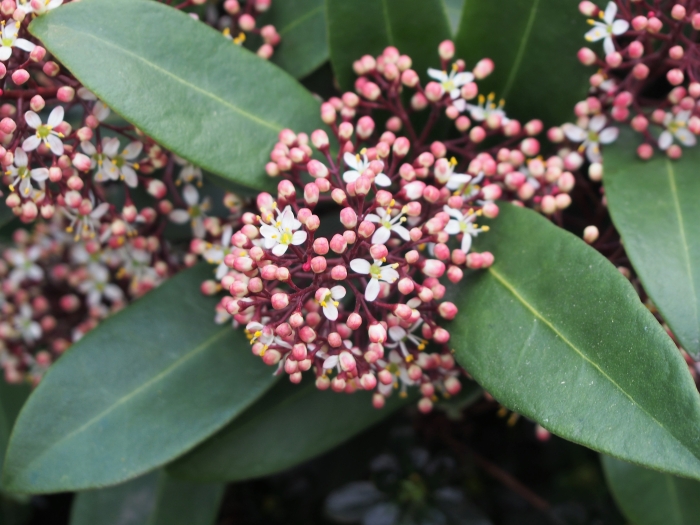Japanese Skimmia
(Skimmia japonica)
Japanese Skimmia (Skimmia japonica)
/
/

Agnieszka Kwiecień, Nova
CC BY-SA 4.0
Image By:
Agnieszka Kwiecień, Nova
Recorded By:
Copyright:
CC BY-SA 4.0
Copyright Notice:
Photo by: Agnieszka Kwiecień, Nova | License Type: CC BY-SA 4.0 | License URL: https://creativecommons.org/licenses/by-sa/4.0 | Uploader: Nova | Publisher: Wikimedia Commons | Title: Skimmia_japonica_'Rubella'_Skimia_japońska_2019-04-06_03.jpg | Notes: {{Information |Description ={{en|1=Location taken: The United States National Arboretum, Washington DC. Names: Sporobolus heterolepis (A.Gray) A.Gray, Northern Dropseed, Prairie Dropseed, Rush Grass, sporobole à glumes inég























































Estimated Native Range
Summary
Skimmia japonica, commonly known as Japanese skimmia, is an evergreen shrub native to the understory of woodlands and forest margins in Japan and Taiwan. It typically grows to a height and width of 4-6 feet (1.2-1.8 meters), forming a dense, rounded shape with glossy, leathery leaves that are aromatic when crushed. The plant produces clusters of fragrant, cream-yellow or white flowers in the spring, which are quite showy and attract pollinators. Female plants, if a male pollinator is present, bear small, round, red berries that persist into winter, adding ornamental interest.
Japanese skimmia is valued for its shade tolerance, fragrant flowers, and attractive berries, making it a popular choice for shaded garden areas, woodland plantings, and as a foundation plant. It is also used in container gardening and can be trained as bonsai. This shrub prefers well-drained, humus-rich soil and benefits from mulching to maintain soil moisture. It requires little maintenance once established but may suffer from pests like scale insects or fungal diseases such as leaf spot. Japanese skimmia is not known for aggressive roots or invasiveness but should be planted with care to avoid overcrowding.CC BY-SA 4.0
Japanese skimmia is valued for its shade tolerance, fragrant flowers, and attractive berries, making it a popular choice for shaded garden areas, woodland plantings, and as a foundation plant. It is also used in container gardening and can be trained as bonsai. This shrub prefers well-drained, humus-rich soil and benefits from mulching to maintain soil moisture. It requires little maintenance once established but may suffer from pests like scale insects or fungal diseases such as leaf spot. Japanese skimmia is not known for aggressive roots or invasiveness but should be planted with care to avoid overcrowding.CC BY-SA 4.0
Plant Description
- Plant Type: Shrub
- Height: 3-4 feet
- Width: 4-5 feet
- Growth Rate: Slow
- Flower Color: Cream, Yellow, White
- Flowering Season: Spring
- Leaf Retention: Evergreen
Growth Requirements
- Sun: Part Shade, Full Shade
- Water: Medium
- Drainage: Slow, Medium, Fast
Common Uses
Bee Garden, Bird Garden, Border Plant, Deer Resistant, Fragrant, Groundcover, Hummingbird Garden, Low Maintenance, Potted Plant, Rabbit Resistant, Street Planting
Natural Habitat
native to the understory of woodlands and forest margins in Japan and Taiwan
Other Names
Common Names: Vinterbär
Scientific Names: , Skimmia japonica, Skimmia japonica var. japonica, Skimmia rogersii,
GBIF Accepted Name: Skimmia japonica Thunb.